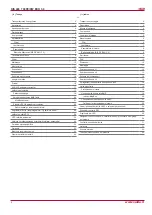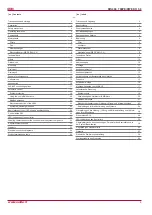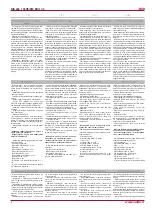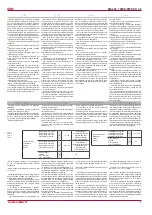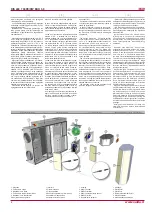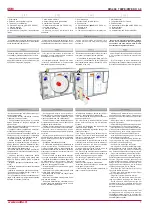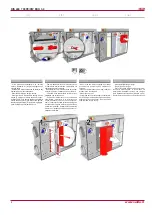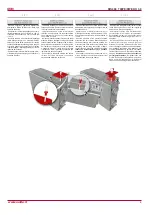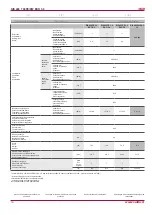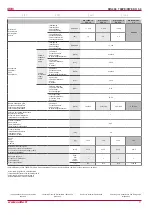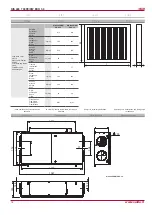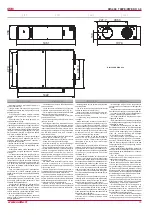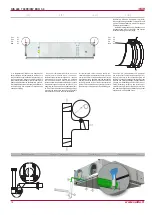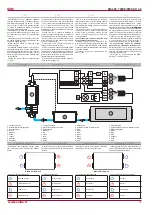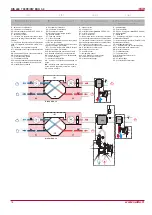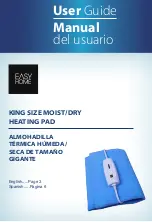
6
RIS 400_700PE/PW EKO 3.0
www.salda.lt
[ lt ]
[ it ]
[ en ]
[ de ]
1. Korpusas
2. Tiekiamo oro filtras
3. Ištraukiamo oro filtras
4. Tiekiamo oro temperatūros jutiklis
5. Ištraukiamo oro ventiliatorius
6. Apėjimo sklendės pavara
1. Housing
2. Supply air filter
3. Exhaust air filter
4. Supply air temperature sensor
5. Exhaust air fan
6. By-pass valve actuator
1. Gehäuse
2. Zuluft-Filter
3. Abluft-Filer
4. Temperaturfühler der Zuluft
5. Abluft-Ventilator
6. Antrieb der Bypass-Klappe
1. Involucro
2. Filtro immissione
3. Filtro estrazione
4. Sensore temperatura di immissione
5. Ventilatore di aspirazione
6. Attuatore valvola by-pass
dinimo įrenginius privaloma visu galingumu
1/24h prapūsti - džiovinti sistemą.
• turi būti instaliuota ir įjungta įtampa į agregato
automatiką, vandeninių gaminių sistema pripil-
dyta glikolio/vandens.
Nesilaikant šių reikalavimų gamintojas turi
teisę gedimo atveju netaikyti garantijos dėl
atsiradusios drėgmės/vandens sugadintuose
komponentuose.
Agregatas gali būti eksploatuojamas iki -40°C
tik su lauko oro pašildytuvu, kuris lauko oro
temperatūrą turi pašildyti iki -3°C. Be lauko oro
pašildytuvo agregatas veiks tik iki -3,5°C kai
naudojamas Toutside priešužšaliminės algori-
tmas arba pagal apskaičiuotą užšalimo tempe-
ratūrą jei naudojamas Klingb priešužšaliminės
algoritmas. Klingb priešužšaliminės algoritmas
apskaičiuoja galimą šilumokaičio užšalimo
temperatūrą pagal iš patalpos ištraukiamo oro
temperatūrą, pagal iš patalpos ištraukiamo oro
drėgnumą ir pagal lauko oro temperatūrą.
Agregatas laikinai sustabdomas dėl šilumo-
kaičio užšalimo rizikos arba dėl per žemos tie-
kiamo oro temperatūros, agregatas pasileidžia
pats, kai dings stabdymo priežastys. Gamy-
kliškai nustatyta, kad kas 3 val. agregatas pa-
sileidžia ~5 min. didžiausiu greičiu ir tikrina, ar
stabdymo priežastys nedingo. Jeigu priežastys
dingo, agregatas veikia nesustodamas tik jau
tuo greičiu, kuris buvo nustatytas prieš stabdy-
mą. Jeigu priežastys nedingo, agregatas po 5
min. stabdomas iki kito patikrinimo. Jeigu pati-
krinimo metu į patalpą tiekiamo oro temperatū-
ra nukrenta žemiau nustatytos ribos, agregatas
stabdomas po maždaug 3min.
Pranešimas ekrane dingsta tik tuomet, kai
agregatas pereina į normalų režimą.
acqua ed eventualmente acqua glicolata.
In caso di mancato adeguamento alle prescri-
zioni di cui sopra il produttore ha il diritto di an-
nullare la garanzia, qualora un guasto dell’unità
risulti causato dalla presenza di condensa sulla
parte elettronica della stessa.
L’unità può lavorare con temperatura dell’aria
esterna di -40° C soltanto con una batteria
elettrica antigelo che porti la temperatura fino
a 3°C. In assenza di batteria antigelo sulla pre-
sa di aria esterna, l’unità può operare soltanto
con temperatura fino a -3,5° C quando è attivo
il sistema antigelo basato sulla temperatura
esterna oppure quello basato sull’algoritmo
Klingenburg per il calcolo della temperatura
di formazione del ghiaccio. Questo algoritmo
calcola la temperatura presunta di formazione
del ghiaccio nello scambiatore basandosi sulla
temperatura ed U.R. dell’aria estratta e sulla
temperatura dell’aria esterna.
L’unità viene fermata momentaneamente quan-
do si presenta il rischio di gelo a causa della
temperatura di immissione troppo bassa e poi
viene riavviata quando il rischio di gelo viene
meno. Per verificare se tale rischio esista an-
cora o meno, ogni tre ore l’unità si avvia alla
massima velocità e opera per 5 minuti. Qualora
le condizioni siano tornate favorevoli, il recu-
peratore ricomincerà a funzionare al regime di
rotazione dei ventilatori impostato precedente-
mente dall’utente. Se, al contrario, le condizioni
non sono tornate favorevoli, l’unità si fermerà
nuovamente fino al successivo ciclo di prova.
Se durante tale ciclo la temperatura dell’aria
immessa dovesse scendere sotto il limite im-
postato dalla fabbrica, l’unità verrebbe fermata
dopo circa 3 minuti.
Un messaggio che avverte della procedura an-
tigelo in atto appare sul pannello di comando
remoto e scompare soltanto quando il funzio-
namento torna ad essere quello normale.
h to dehumidify.
• Voltage to the automatics of the unit is installed
and connected; the system of water products is
filled with glycol/water.
In case of failure to comply with the require-
ments set out above, the manufacturer shall have
the right not to apply the warranty in respect of
the occurrence of moisture/water in damaged
components.
The unit can work at -40 ° C only with outdoor
air pre-heater, which must warmed outdoor air
up to -3 ° C temperature. Without outdoor air
pre-heater, the unit will work only to -3.5 ° C
when using the Toutside anti-frost algorithm or
the calculated freezing temperature if Klingb
anti-frost algorithm is used. The Klingb anti-
frost algorithm calculates the potential freezing
temperature of the heat exchanger according
room air temperature, room humidity and outdoor
air temperature.
The unit is temporarily stopped due to the risk
of freezing the heat exchanger or because of
the low supply air temperature, the unit starts up
itself when the freezing risk disappear. Factory
that every 3 hours the unit starts up for ~ 5 min.
at the highest speed and check didn’t disap-
peared heat exchanger frost risk. If the reasons
have disappeared, the unit will work normally
at the speed that was set before the frost risk.
If the reasons have not disappeared, the unit
after 5 min. is temporarily stopped until the next
inspection. If during the test the temperature of
the supply air falls below the set limit, the unit is
stopped after about 3 minutes.
The message on the screen disappears only
when the unit goes into normal mode.
• Werden die Lüftungseinrichtungen nur selten
betrieben oder Betriebspausen ausgesetzt, so ist
das System einmal in 24 Stunden mit maximaler
Leistung zu belüften und zu trocknen.
• Die Steuerungselektronik der Lüftungsein-
richtung ist montiert und stromgespeist. Das
Wassersystem ist mit Mischung von Glykol und
Wasser befüllt.
Der Hersteller übernimmt keine Gewähr-
leistung, die im Folge der Nichtbeachtung
oben genannten Anweisungen und daraus
resultierenden Einrichtungsbeschädigungen
durch Feuchtigkeits-bzw. Wassereinwirkung
entstehen.
Das Gerät kann bis auf -40 ° C nur mit dem
Vorheizregister betrieben werden, die Außen-
lufttemperatur muss bis auf -3 ° C vorerwärmt
werden. Ohne Vorheizregister kann das Gerät
nur bis bis auf -3,5 ° C Aussentemperatur arbei-
ten, wenn Frostschutzstrategie nach Algorithmus
Toutside oder Frostschutzstrategie Klingb nach
berechnetem Frostpunkt verwedet wird. Klingb
Froststrategie berechnet das mögliche Einfrieren
des Wärmetauschers gemäß der Ablufttempe-
ratur aus dem Raum, Raumabluftfeuchte und
Aussenlufttemperatur.
Das Gerät wegen Frostgefahr und zu niedri-
gen Zulufttemperaturen wird vorübergehend
gestoppt. Das Gerät schaltet sich ein, wenn
die Voraussetzungen für das Einfrieren des
Wärmetauschers weg sind. Werkseinstellung
nach schaltet sich das Gerät jede 3 Stunden
für ca. 5 Minuten in höchster Stufe ein um zu
prüfen, ob die Voraussetzungen für Einfrieren
des Wärmetauschers weg sind.
Wenn die Voraussetuzngen für das Einfrieren
des Wärmetauschers weg sind, dann arbeitet
das Gerät weiter wie vorher eingestellt. Wenn
die Voraussetzngen für das Einfrieren des
Wärmetauschers nicht weg sind, dann wird das
Gerät nach 5 Minuten bis zur nächsten Überprü-
fung gestoppt. Wenn während der Prüfung die
Zulufttemperatur unter eingestellter Temperatur
runterfällt, dann wird das Gerät nach 3 Minuten
gestoppt.
Anzeige auf dem Bedienteil nur dann ver-
schwindet, wenn das Gerät in Normalbetrieb
zurückkommt.


